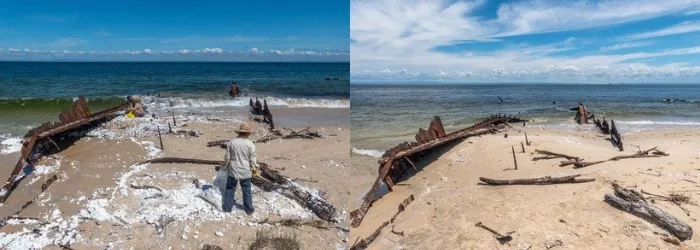The Perils of Polystyrene

The Perils of Polystyrene
The recent floods certainly left their mark at Bulwer Wrecks
A massive amount of rubbish was washed up on the beaches of Mulgumpin (Moreton Island) from the recent South-East Queensland floods. On Clean Up Australia Day, the Lord Mayor of Brisbane, Adrian Schrinner arrived by helicopter at the Bulwer Helipad to witness the disaster. The Courier Mail headline the next day read, “ISLAND PARADISE TURNED INTO PLASTIC DISASTER ZONE BY FLOOD FALLOUT”.
A major problem was Polystyrene from pontoons breaking up. An 8 x 3.5m pontoon dragged for days across the Bulwer Wrecks and littered the beach with so many tiny balls of Polystyrene it looked like snow.
The pontoon was eventually removed from the water by the Micat Ferry end loader on Sunday. Boats and pontoons, amongst a swathe of other rubbish and debris covered the beaches. Particularly high tides continued to wash up more rubbish – even after the beaches had been cleaned.
The Clean Up of Bulwer Beach started at the height of the floods the week before. A number of concerned locals picked up tonnes of rubbish by the trailer-load. A live cane toad was found washed up on debris, as well as stonefish and even a dead llama.
Moreton Island Protection Committee’s (MIPC) event saw members and other volunteers clean up over Friday, Saturday and Sunday. Bulwer Progress and Social Association again assisted with volunteer accommodation and Micat offered discounted fares. Sunday’s Clean Up Australia Day had 16 registered volunteers assist the many locals who had already spent four or five days cleaning up the mess. Heavy machinery provided by Micat and Scott Bielenberg helped make the task easier by getting rubbish into waste management bins placed on the beach. The Clean Up continues well after our event with Sea Shepherd, QYAC and QPWS Rangers and locals still tackling the problem.
An abundance of historical litter such as plastic straws, light sticks used by commercial fishing, small plastic fish-shaped soy sauce containers, plastic toothbrushes, needles and syringes, masses of plastic water and soft drink bottles and lids, thongs, ribbons with balloon remnants, and all forms of micro plastic continue to be collected – all having high detrimental impact on the environment and wildlife.
Moreton Island Protection Committee has found Polystyrene washing up on the island for decades. The recent floods have revealed pontoons to be a major source. Beaches on the Sunshine Coast to Fraser Island were also littered with breaking up pontoons.
Some of the pontoons are of 1 – 2 metre thick Polystyrene block – supporting an artificial grassed concrete deck. One of the pontoons washed up on our site was 8 x 3.5 metres.
There were broken Polystyrene blocks to a metre long, along with smaller pieces, washed into all the island’s creeks. When it breaks up into tiny beads, it blows through dune grass and into vegetation – therefore not only affecting marine life as it floats in the sea – but all wildlife in proximity to shorelines and beyond. It is a serious problem too easily overlooked.
It was a Clean Up Australia the likes of which none of us ever want to see again. Our society seemingly ignores sustainability. Massive amounts of rubbish and plastic waste severely affect us and our environment. The problem of cheap toxic Polystyrene dependence was obvious in overwhelming proportions. It is certainly time for community changes in attitude – doing nothing risks everything.
Polystyrene (also known as Styrofoam or EPS Foam is a synthetic aromatic hydrocarbon polymer and one of the world’s biggest health and environmental hazards, despite false marketing from its manufacturers. There are a number of Polystyrene manufacturers in south east Queensland.
- Polystyrene takes up more landfill than any other waste – 30% globally.
- Polystyrene is not only a dangerous air pollutant but also poses a great threat to humans, the environment and wildlife.
- Polystyrene is not biodegradable and takes over 500 years to decompose.
- Polystyrene during decomposition leaches harmful chemicals into the environment.
- Polystyrene as a commercial product has been banned in many cities, states and countries which include California, Seattle, Washington, Portland, Toronto, Paris, Manila and Taiwan.
- Polystyrene contains Styrene which leaches into and contaminates food and drinks served in Polystyrene containers, affecting human health and reproductive systems.
- Polystyrene exposed to sunlight creates harmful air pollutants, contaminates landfill and depletes the ozone layer.
- Polystyrene during manufacture releases large amounts of ozone into the atmosphere, causing respiratory and environmental issues.
- Polystyrene easily breaks apart into small pieces which severely affects marine and wildlife.
- Polystyrene is affected by sunlight in a process called photodegradation – which alters the outer layer of the plastic – discolouring it and turning it into a toxic powdery substance.
- Polystyrene manufacture releases over fifty chemical byproducts which contaminates air and water and affects communities living near the manufacturing facility.
- Polystyrene’s released byproduct; Styrene is believed to be a carcinogen.
Exposure to Styrene can cause irritation to the skin, eyes, upper respiratory tract and gastrointestinal tract.
- Styrene overexposure can cause more severe effects such as depression, headaches, fatigue, weakness, hearing loss and disrupted kidney function.
- Styrene at manufacture creates ground-level ozone which can impair lung function, lead to respiratory illness and also impair the nervous system.
*Source: www.ecofriendlyhabits.com
